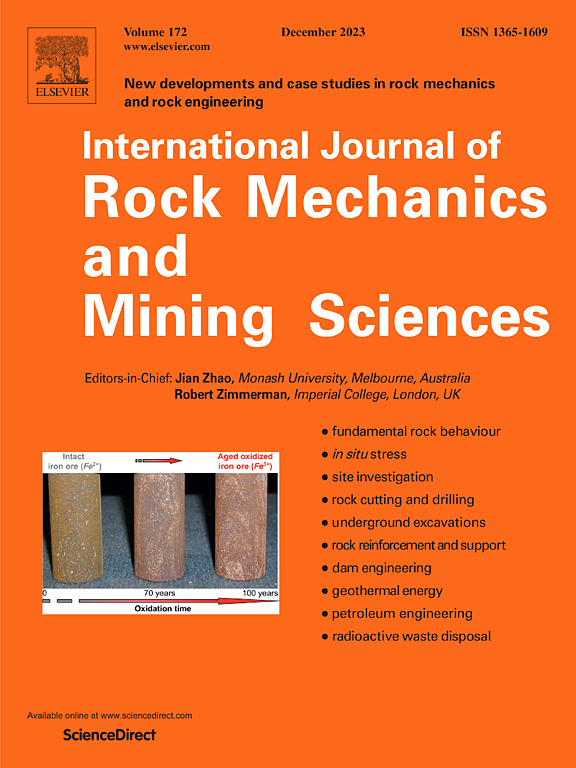Analysis of grout radial propagation in water-saturated rough-walled rock fractures
IF 7
1区 工程技术
Q1 ENGINEERING, GEOLOGICAL
International Journal of Rock Mechanics and Mining Sciences
Pub Date : 2025-04-05
DOI:10.1016/j.ijrmms.2025.106101
引用次数: 0
Abstract
Understanding the propagation behavior of cement grout in rough-walled fractures is crucial for predicting its effectiveness and design of optimal grouting schemes. To investigate radial propagation of cement grout in saturated rough-walled fractures, a water-cement grout two-phase flow model in rough-walled rock fractures is developed using the phase field method, Herschel-Bulkley model, and mass and momentum conservation equations. Then, the established model is validated against analytical solutions and rough fracture grouting tests. Subsequently, the sensitivity of grout propagation versus grout rheological properties, injection pressure and fracture geometry is analyzed. Simulation results reveal that the increase in water-to-cement ratio (W/C) and injection pressure can enhance the filling rate and flow rate of cement grout in rough-walled fractures. Nevertheless, regardless of adjusting W/C and injection pressure, there is a maximum filling rate for a certain fracture that cannot be exceeded. An increase in the relative standard deviation (RSD) of fracture aperture may promote preferential paths' formation to facilitate better penetration by the grout; although, excessive RSD may enlarge areas where it is difficult for grout to penetrate effectively. Additionally, the fracture shear direction significantly affects the propagation direction of cement grout, with preferential propagation occurring perpendicular to the fracture shear direction. Finally, the comparison between the rough-walled fracture model and smooth parallel-plate fracture models from previous research indicates that the smooth parallel-plate models might overestimate the grout filling rate by about 30 %, while significantly underestimating the grout flow. These results provide valuable insights for more accurate predictions of grouted penetration ranges and for optimizing rock grouting methods such as real-time grout control (RTGC).
含水粗壁岩石裂隙中浆液径向扩展分析
了解水泥浆液在粗壁裂缝中的扩展特性,对于预测其有效性和设计最佳灌浆方案至关重要。为了研究水泥浆在饱和粗壁裂缝中的径向扩展,采用相场法、Herschel-Bulkley模型和质量动量守恒方程建立了粗壁岩石裂缝中水-水泥两相流动模型。通过解析解和粗裂注浆试验对模型进行了验证。随后,分析了浆液扩展对浆液流变特性、注入压力和裂缝几何形状的敏感性。模拟结果表明,增大水灰比(W/C)和注入压力可以提高粗壁裂缝中水泥浆的充填速率和流速。然而,无论如何调节水力比和注入压力,对于某条裂缝,都存在一个不能超过的最大充填率。裂缝孔径相对标准偏差(RSD)的增大可能促进优先通道的形成,有利于浆液更好的穿透;然而,过高的RSD可能会扩大浆液难以有效渗透的区域。裂缝剪切方向对水泥浆液的扩展方向影响显著,垂直于裂缝剪切方向优先扩展。最后,将粗壁断裂模型与光滑平行板断裂模型进行对比,发现光滑平行板模型可能高估了30%左右的灌浆速率,而严重低估了浆液流量。这些结果为更准确地预测注浆渗透范围和优化岩石注浆方法(如实时注浆控制(RTGC))提供了有价值的见解。
本文章由计算机程序翻译,如有差异,请以英文原文为准。
求助全文
约1分钟内获得全文
求助全文
来源期刊
CiteScore
14.00
自引率
5.60%
发文量
196
审稿时长
18 weeks
期刊介绍:
The International Journal of Rock Mechanics and Mining Sciences focuses on original research, new developments, site measurements, and case studies within the fields of rock mechanics and rock engineering. Serving as an international platform, it showcases high-quality papers addressing rock mechanics and the application of its principles and techniques in mining and civil engineering projects situated on or within rock masses. These projects encompass a wide range, including slopes, open-pit mines, quarries, shafts, tunnels, caverns, underground mines, metro systems, dams, hydro-electric stations, geothermal energy, petroleum engineering, and radioactive waste disposal. The journal welcomes submissions on various topics, with particular interest in theoretical advancements, analytical and numerical methods, rock testing, site investigation, and case studies.

 求助内容:
求助内容: 应助结果提醒方式:
应助结果提醒方式:


